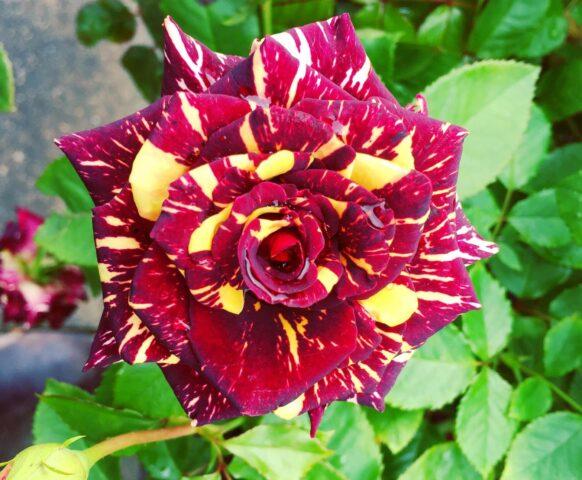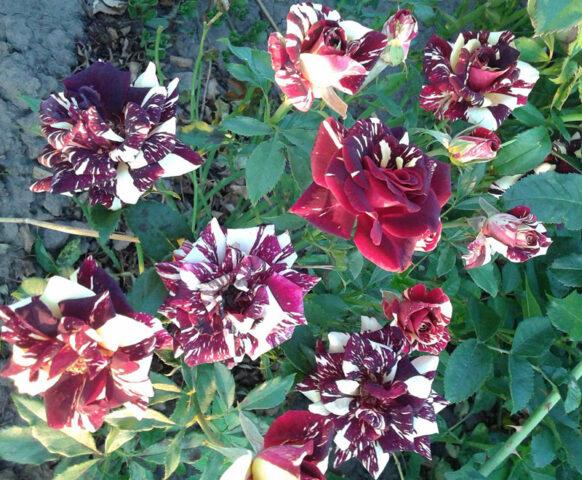Content
The climbing rose Abracadabra is a beautiful perennial with a bright and original color that combines several shades. This variety is widely used in landscape design and is used for cutting. Plant care must be comprehensive; preparation for winter is mandatory.
History of selection
The history of the Abracadabra rose variety began in 1991 from a Californian nursery. Its author is William Warriner. In 1993, the plant was presented under the name Abracadabra at an exhibition. This was done by Jackson & Perkins. The new product was obtained from the large-flowered hybrid tea varieties Tribute and White Masterpiece.
In 2002, the German company Cordes and Sons developed the Abracadabra rose, using its own flower, Hocus Pocus, as a basis. Both varieties are incredibly similar, which is why they are often confused.
Two years later, another variety of rose appeared in the same nursery. Under the name Abracadabra, it was officially presented only in 2014. The difference between this variety is the predominance of white and light pink shades, greater terry.
Description of the Abracadabra climbing rose and characteristics
Rose Abracadabra is a floribunda, that is, it belongs to a group that occupies an intermediate position between the hybrid tea and polyantha classes. A characteristic feature of the buds is their complex color. They have a rich red-burgundy background with white and yellow inclusions - stripes, spots, strokes. Unlike Hokus Pocus, they are more pronounced in this climbing variety.

Due to their variegated color, it is impossible to find identical flowers of the climbing Abracadabra.
The predominance of a particular shade in the color of Abracadabra roses cannot be predicted. Sometimes the dark background takes precedence, and the light inclusions are insignificant. In other cases, some petals may appear completely yellow. Gardeners often note that the color of buds on the same bush differs markedly in different years. For the first time they may be plain, often yellow. The color will change in future seasons.
Rose Abracadabra grows on average to 0.7-0.8 m, when grown on a trunk up to 1.5 m. Its vines are long, reaching 1.5-2 m. The shape of the bush can be upright or spreading. Its width can reach 1.2 m.
Climbing Abracadabra prefers warm and sunny places, but the light should not be direct. Partial shade is recommended in the afternoon. The absence of cold winds is important for the plant. The soil should be moist and well-drained, preferably loamy. Stagnation of water is unacceptable. Recommended acidity 5.6-7.3 pH.
The climbing rose Abracadabra has dark green, dense foliage. When grown in open ground, a brownish tint may appear. There is a characteristic glossy shine.There are practically no thorns on the shoots.
Peduncles are long when one bud is formed on them. They are then located on erect stems. Peduncles may be short. Then there are up to three buds on them.
The stems of the climbing rose Abracadabra are rich green, dark emerald after lignification. The diameter of its double flowers is 6-7 cm; when fully opened, it can be twice as large. The petals are velvety, the tips are pointed. The aroma of the plant is weak, but persistent and pleasant.
The climbing Abracadabra blooms repeatedly. If you properly care for the plant, it lasts all summer. In direct sunlight, poor soil or constant drafts, flowering may not occur. It comes into full force in June. Until autumn there are 2-3 waves. When grown in open ground, there are short breaks between them.
Flowering may continue until frost as the last buds form in early fall. In greenhouses and greenhouses it will last almost all year round if you organize competent comprehensive care. Under such conditions, the maximum number of buds is obtained.
The climbing rose Abracadabra is considered a cut variety. It can stand for up to 16 days, maintaining its attractiveness.
Rose Abracadabra belongs to zone 6b in terms of winter hardiness. This means that the plant can withstand temperatures down to -20.6 °C.
Advantages and disadvantages of the variety
Climbing Abracadabra attracts gardeners with its variegated colors and its unpredictability. Even one such rose can revive a bouquet and make it original.

On one bush of climbing Abracadabra you can find both variegated and plain flowers
Pros:
- interesting coloring;
- re-blooming;
- good immunity;
- good winter hardiness;
- long shelf life when cut.
Minuses:
- susceptibility to black spotting;
- poor resistance to rain.
Reproduction methods
The climbing rose Abracadabra is propagated by cuttings. To harvest them, you need to choose young but strong bushes. Cuttings are cut when the first wave of flowering ends.
The Abracadabra rose can also be propagated by grafting (budding). To do this, you need a rosehip rootstock with a developed root system.
Growing and care
The Abracadabra climbing rose is planted at the end of April or beginning of May or during October. If you choose spring, you need to wait until the soil warms up. Autumn planting is allowed only in warm regions, as the plant needs time to take root.
The selected area needs to be dug up to 0.3. The depth of the planting pit is 0.5-0.7 m, the width is the size of the earthen clod. Drainage is required - gravel, crushed stone, expanded clay. A layer of 0.1 m is enough. The soil is suitable as follows:
- three parts manure;
- two parts each of sand and fertile soil;
- part of the peat.
Seedlings need to be purchased from trusted places to obtain a specific variety. You can order the hybrid tea rose Abracadabra in the Sadovita online store. After purchasing, proceed as follows:
- Shorten the roots of the seedling, remove damaged ones, trim the shoots to 2-3 buds.
- Dip the cuttings in a mixture of cow dung and clay (1:2).
- Place the seedling in the planting hole and straighten the roots.
- Compact the soil, deepening the neck by 5 cm.
- Water the bush at the root.
The climbing rose Abracadabra should be watered generously once a week, more often in hot weather. 15-20 liters of non-cold water is enough per bush. By autumn, reduce moisture, and stop in September.
The first feeding is carried out after wintering. Add nitrogen fertilizer and mullein (dilute in water 1:7). When forming buds, it is important to increase the number of ovaries. To do this, for 1 m² you need a bucket of water with minerals dissolved in it:
- 15 g of potash fertilizer;
- 20 g of saltpeter;
- 40 g superphosphate.
The climbing rose Abracadabra responds well to alternating mineral compositions and organic matter. When flowering again, it is necessary to reduce the proportion of nitrogen, but increase the dose of potassium fertilizers.
The climbing rose Abracadabra needs to be weeded regularly. The ground around the bush must be loosened periodically.
In spring, sanitary pruning is needed. After this, the bushes need to be shortened to 3-5 buds. Pruning is also carried out in the summer to enhance flowering. You can delay it for a month by pinching the ends of the shoots.
Unripe shoots, flowers and leaves should be removed only before insulation. When stable cold weather arrives, cover the bushes with peat to a depth of 0.2 m and cover them with spruce branches. If the winter is harsh or with little snow, then additional insulation with fabric or sawdust is required.
Pests and diseases
The climbing rose Abracadabra has moderate disease resistance. The flower may suffer from black spot. The fungal infection starts from the bottom. Round purple-white spots appear on the leaves. Gradually they turn black. All affected parts of the plant must be removed and burned. Spraying with copper sulfate, Bordeaux mixture, Fundazol, Topaz, Previkur, Strobi, Ridomil Gold is effective for treatment.

Due to black spotting, the plant may lose almost all its foliage and there will be no flowering.
Application in landscape design
Thanks to its variegated color, the climbing rose Abracadabra looks good even when alone. It can be planted against the background of conifers - juniper, thuja, spruce.

A minimum of 1.5 m must be left between the Abracadabra climbing rose and fruit or ornamental shrubs.
The combination of the Abracadabra rose with the following plants looks impressive: euonymus, privet, wolfberry (snowberry), comb (tamarisk), caragana (yellow acacia), cotoneaster, pshat, lilac, mackerel, mock orange.

Variegated Abracadabra looks good with solid colors
The Abracadabra variety can be planted next to other climbing roses. Preference should be given to monochromatic varieties.

The combination of climbing Abracadabra with conifers is more suitable for decorating parks
Conclusion
The climbing rose Abracadabra attracts with its original variegation and repeated flowering. It can be grown in open ground or in greenhouses and greenhouses, where buds will appear almost all year round. Caring for this variety is standard; insulation is required for the winter.
Reviews with photos about the Abracadabra rose











